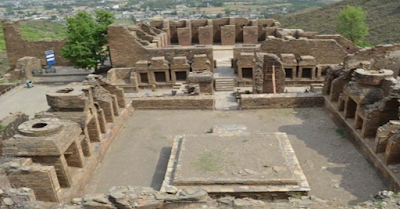Taxila, Center of Ghandhara Civilization, One of the greatest center of Buddhist Civilization. A great world cultural heritage of human history, The land of first University of the World.
22 miles from
Rawalpindi, towards the northwest was an ancient city called Taxilaabad. In 326 BC, Alexander the Great captured this
city and stayed here for five days. It
was here that Raja Ambhi accepted Alexander's obedience, after which Alexander
reached the banks of the Jehlum to fight the Rajapuras. Demetrius, the Greek ruler of Bactria,
conquered the Gandhara region in 190 BC and made Taxila his capital. Even during the era of Maharaja Ashoka, the
city was at its peak and it was the center of Buddhist learning.
In the 7th century AD, the famous Chinese traveler Hien Tsang
came here. He has mentioned the
greatness of this city in his travelogue.
There is a Gothic-style museum, which houses Gandhara art pieces from
the 5th century BC, ten thousand coins (some of which are from the Greek
period), jewelry, utensils and other artefacts. The great pre-Christian remains at Taxila are
also on the UNESCO World Heritage List.
The ancient city of
Taxila is situated between the Indus River and the Jhelum River. In Sanskrit it was known as Takshasala and
locally as Takasala. The Greeks and
Romans called it Taxila. The city was a
major trading center in ancient times due to its location at the junction of
three major trade routes. South Indian,
Western and Central Asian trade routes converged here.
The ancient European
nations were familiar with the name Taxila from the time of Alexander the
Great's invasion of India. Taxila was a
province of Iran in the 6th century BC.
In the following centuries, the city was ruled by royal families of
different generations for at least seven periods.
Bazar, which is now in
ruins, was first excavated in 1913 by the Archaeological Survey of India during
the British colonial period to find the remains of the ancient civilization of
Taxila, which continued until 1934.
Then, before and after the formation of Pakistan, many famous European
and Pakistani archaeologists continued to excavate here. Where dry grass and stones are seen now,
centuries ago people used to walk in crowded markets.
Stupas and Monasteries
Excavations in the Taxila valley have resulted in the discovery of more than
two dozen stupas and monasteries. These
include Dharma Rajika, Julian, Mohara Muradu, Pelaan, Gari, Bhamala, Jandial,
Jananwali Dheri, Badalpur, Bhalardup, Kanala and Kalavan.
University of Ancient Taxila At the end of the ruins of the ancient city of Taxila, there is a central and magnificent place towards Prince Kanala's Stupa, which according to Pakistan's renowned archaeologist Prof. Dani, is the same place where the famous University of Taxila was established centuries ago.
First University of the world.
Founded 2600 years ago, the seminary is considered to be the first university in the world.
Located 22 miles northwest of Rawalpindi, Taxila is a historic city founded in 600 BC, its name in the pages of history is Takshashila. Now a days Texila Pakistan.
In the holy books of Buddhism, Jataka, the university is remembered as a centuries-old center of learning. The longest and most systematic narrative of the Hindu religion is also mentioned in Mahabharata, which has the status of a religious scripture.
Prince Kanala's Stupa
Some distance away from the ancient university of Patiksala is the Prince
Kanala Stupa. A magnificent building
once stood near this stupa. Now only the
stone remains of this building remain.
Excavations at this site and its vicinity have also yielded many ancient
coins and pots made of clay and metal.
Fragile but still preserved,
the stupa found by archaeologists in Room No. 9 of the Majlis House of Mohra
Muradu, is made of limestone but still remains in its original state despite
the passage of centuries. From the same
monastery, experts have also found sculptures made of lime clay. Other artefacts found at Mohra Muradu include
food and drink utensils, household utensils, various tools and copper vessels.
Taxila Museum Taxila Museum is one of the most beautiful
museums in Pakistan. Located on Haripur
Road, this museum was designed by Principal Sullivan of the Mayo School of Arts
(now National College of Arts) in Lahore.
It was founded by Lord Chelmsford, Viceroy of British India. The museum houses more than 700 artefacts
from Taxila, but photography is not allowed inside the museum.
The historical remains
of the city of Sirkup are about two kilometers from the Taxila Museum. In the second century BC, the Greeks of
Bactria attacked Taxila, ending the Maurya Empire, they established their own
government and settled a new city, Sirkup.
The city was settled on a chess board pattern. Its ruins are also very unique due to its
straight streets and bazaar. This city
was settled inside a wall, which had four gates.
About five kilometers
to the east from the Taxila Museum is the Mohara Muradu monastery. It consists of a Buddhist shrine, a central
s tupa and the remains of a monastery, which housed the living quarters of the
priests, their hall, kitchen, bath and storehouse. The remains show how disciplined construction
was practiced in this period as well.
Most of the remains of
Buddhist temples found in the Taxila Valley date from the 1st century AD to the
5th century AD. The Dharma Rajika Stupa
dates back to the 3rd century AD, and was included in the UNESCO World Heritage
List in 1980. Many of these historical
sites are still in surprisingly good and clear condition.
.webp)


.jpg)
.jpg)
.jpg)


,%20One%20of%20the%20Oldest%20Civilizations%20of%20World,%20Their%20Society,%20Culture%20and%20Living%20Style.jpg)
0 Comments